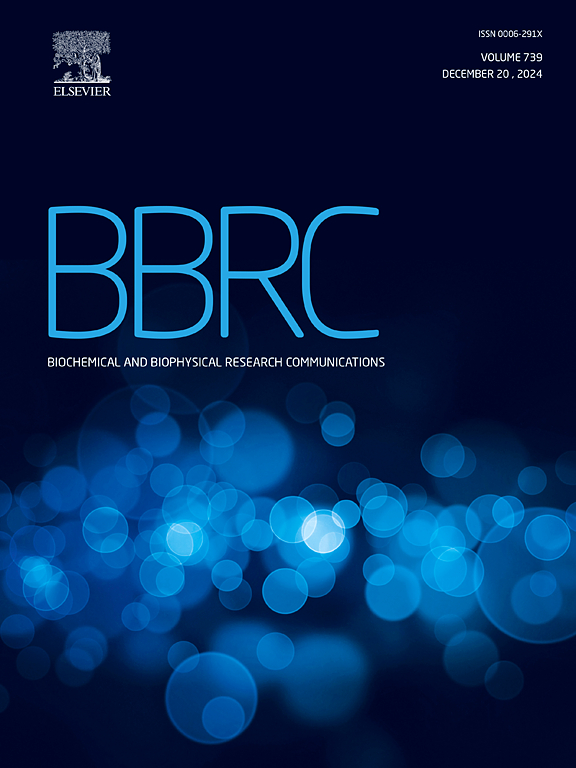Prolonged self-assembly of H. pylori ferritin globules at physiological conditions
IF 2.5
3区 生物学
Q3 BIOCHEMISTRY & MOLECULAR BIOLOGY
Biochemical and biophysical research communications
Pub Date : 2025-01-01
DOI:10.1016/j.bbrc.2024.151205
引用次数: 0
Abstract
One of the promising drug delivery tools is ferritin, which features high stability at a wide range of conditions and protects cargo by its spherical protein shell. We studied the self-assembly into homoglobules of ferritin from H. pylori and a chimeric protein ferritin-SUMO. We exposed the globules to pH-driven dis/reassembly and in both cases we observed two fractions during size exclusion chromatography (SEC) procedure. The higher molecular weight fraction contained fully assembled globules of ferritin and ferritin-SUMO that well coincides with literature. Interestingly, the lower molecular weight fraction contained intermediate subglobular oligomers that also formed globules, but on a time scale of hours, while being under physiological conditions. We performed biochemical characterization of this fraction and found that, in the case of ferritin, it contained almost the whole range of intermediate oligomers with different stoichiometry. In contrast, the ferritin-SUMO fraction contained only two distinct states: dimers and globules, without any other ferritin-SUMO intermediate oligomers. We built AlphaFold-derived schemes of ferritin and ferritin-SUMO self-assembly which also indicated differences in their assembly pathways. Our results could potentially open the possibility of cargo loading into ferritins at physiological conditions and improved purification of ferritin-based products if using a ferritin-SUMO modification with following cleavage of the SUMO-tag by the SUMO protease.
生理条件下幽门螺杆菌铁蛋白球的自组装时间延长。
铁蛋白是一种很有前途的药物输送工具,它具有在广泛条件下的高稳定性,并通过其球形蛋白质外壳保护货物。我们研究了来自幽门螺杆菌的铁蛋白和铁蛋白- sumo的嵌合蛋白的自组装成同源红蛋白。我们将微球暴露在ph驱动的分离/重组中,在两种情况下,我们在尺寸排除色谱(SEC)程序中观察到两个部分。较高分子量的部分含有完全组装的铁蛋白和铁蛋白- sumo球,这与文献非常吻合。有趣的是,在生理条件下,较低分子量的部分含有中间亚球状低聚物,这些低聚物也形成了球状,但在小时的时间尺度上。我们对这部分进行了生化表征,发现在铁蛋白的情况下,它包含了几乎所有的中间低聚物,具有不同的化学计量。相比之下,铁蛋白- sumo片段只包含两种不同的状态:二聚体和球状,没有任何其他铁蛋白- sumo中间低聚物。我们构建了铁蛋白和铁蛋白- sumo自组装的alphafold衍生方案,也表明了它们组装途径的差异。我们的研究结果可能潜在地开启了在生理条件下将货物装载到铁蛋白中的可能性,如果使用铁蛋白-SUMO修饰,并通过SUMO蛋白酶切割SUMO标签,则可以提高铁蛋白基产品的纯化。
本文章由计算机程序翻译,如有差异,请以英文原文为准。
求助全文
约1分钟内获得全文
求助全文
来源期刊
CiteScore
6.10
自引率
0.00%
发文量
1400
审稿时长
14 days
期刊介绍:
Biochemical and Biophysical Research Communications is the premier international journal devoted to the very rapid dissemination of timely and significant experimental results in diverse fields of biological research. The development of the "Breakthroughs and Views" section brings the minireview format to the journal, and issues often contain collections of special interest manuscripts. BBRC is published weekly (52 issues/year).Research Areas now include: Biochemistry; biophysics; cell biology; developmental biology; immunology
; molecular biology; neurobiology; plant biology and proteomics

 求助内容:
求助内容: 应助结果提醒方式:
应助结果提醒方式:


